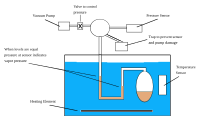Isoteniscope

So, you know how when you put something heavy on a soft bed, it sinks a little bit? That's because the bed is squishy and lets the heavy thing push down into it. Well, scientists came up with something called an isoteniscope, which is basically a machine that helps them see how squishy different materials are.
Here's how it works: They take a tiny sample of the material they want to test and put it in a small container. Then they weigh the container with the material inside of it - like if you put your lunch in a lunchbox and weighed it before you took it to school.
Next, they very carefully push down on the material inside the container with a little stick. This is like when you try to push down on a balloon or a squishy toy. They push down on it a little bit, then weigh the container again to see if it got heavier or lighter.
This is where it gets a little bit tricky. They keep pushing down on the material inside the container over and over again, each time weighing the container to see how much the material sinks down when they push on it. They do this process multiple times until they can see a pattern.
Eventually, they have a bunch of measurements that tell them how squishy the material is - sort of like if you counted how many jumps you could do in a row and that told you how athletic you are.
Scientists use this information to learn more about different materials and how they react to pressure. It helps them understand things like how bridges and buildings are built to hold up heavy things without squishing down too much.
Here's how it works: They take a tiny sample of the material they want to test and put it in a small container. Then they weigh the container with the material inside of it - like if you put your lunch in a lunchbox and weighed it before you took it to school.
Next, they very carefully push down on the material inside the container with a little stick. This is like when you try to push down on a balloon or a squishy toy. They push down on it a little bit, then weigh the container again to see if it got heavier or lighter.
This is where it gets a little bit tricky. They keep pushing down on the material inside the container over and over again, each time weighing the container to see how much the material sinks down when they push on it. They do this process multiple times until they can see a pattern.
Eventually, they have a bunch of measurements that tell them how squishy the material is - sort of like if you counted how many jumps you could do in a row and that told you how athletic you are.
Scientists use this information to learn more about different materials and how they react to pressure. It helps them understand things like how bridges and buildings are built to hold up heavy things without squishing down too much.
